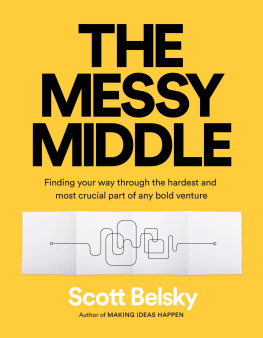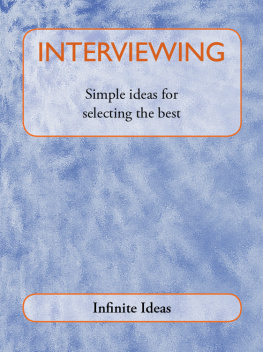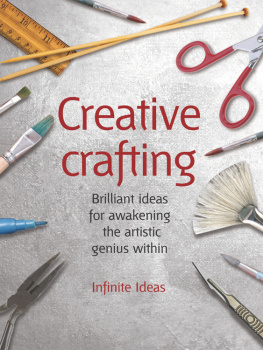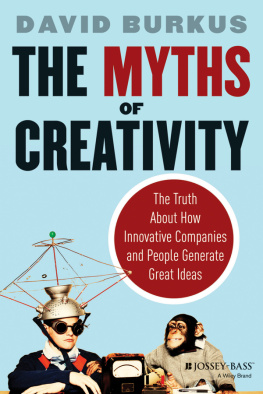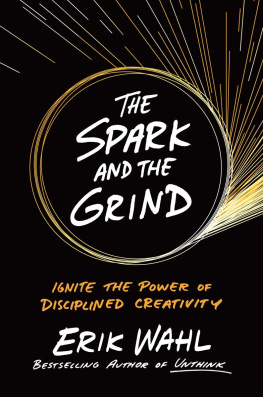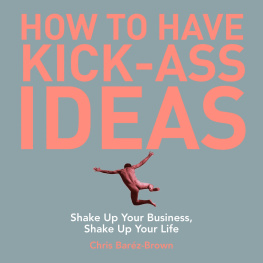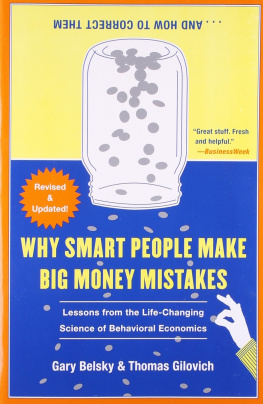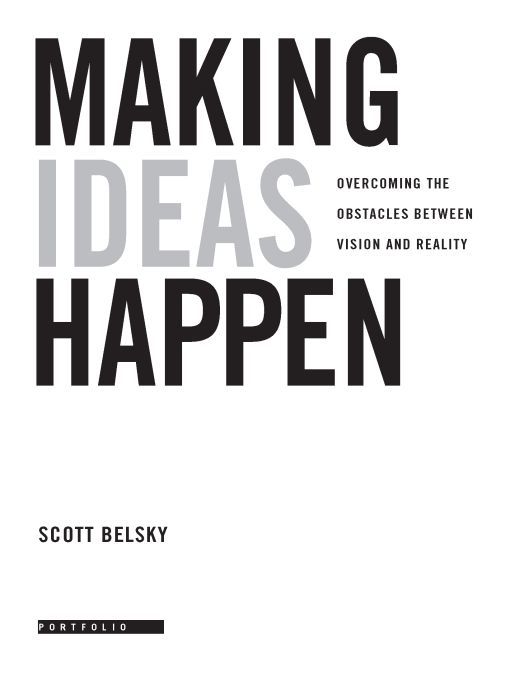Table of Contents
To Nancy and Mark,
with gratitude for the
precious opportunity
of endless possibility
INTRODUCTION:
Making Ideas Happen
IDEAS DONT HAPPEN because they are greator by accident. The misconception that great ideas inevitably lead to success has prevailed for too long. Whether you have the perfect solution for an everyday problem or a bold new concept for a creative masterpiece, you must transform vision into reality. Far from being some stroke of creative genius, this capacity to make ideas happen can be developed by anyone. You just need to modify your organizational habits, engage a broader community, and develop your leadership capability.
This book aims to take pie-in-the-sky notions of how the creative process unfolds and bring them down to earth. Creative people are known for winging it: improvising and acting on intuition is, in some way, the haloed essence of what we do and who we are. However, when we closely analyze how the most successful and productive creatives, entrepreneurs, and businesspeople truly make ideas happen, it turns out that having the idea is just a small part of the process, perhaps only 1 percent of the journey.
Thomas Edison once famously quipped, Genius is 1 percent inspiration and 99 percent perspiration. For the creative mind, inspiration comes easily. But what makes up the other 99 percent of making ideas happen? Read on for a surprisingly pragmatic set of insights and tips that have emerged from over six years spent studying the behaviors and skill sets of those who make their ideas happen again and again.
A QUICK PRIMER:
Making Your Ideas Happen
In the sections ahead, we will discuss the methods behind spectacular achievementsideas that have overcome the odds and become realities. But before we do, heres a primer on a few terms I use throughout the book and some assumptions I make about you (and your ideas)!
You have ideas that you want to make happen. Whatever your business or industry, success is dependent on developing and executing new ideas. Were not just talking about new products, new business ideas, or your vision for the next great American novel. You likely come up with creative solutions to problems every day. Unfortunately, regardless of how great your ideas may be, most of them will never happen. Most ideas get lost in what I call the project plateau, a period of intense execution where your natural creative tendencies turn against you. As a leader in your industry (and the leader of your life), you must learn to defy these tendencies.
You can develop the capacity to make ideas happen. From years of researching creative individuals and teams, I will share the practices used to make ideas happen, time and time again.
Making ideas happen = Ideas + Organization + Communal forces + Leadership capability. There is a framework for all of the insights and methods we will discuss. Aside from generating ideas (which we will not discuss), the capacity to make ideas happen is a combination of the forces of organization, community, and leadership. We will dive into each of these forces and discuss how you should use them in your own creative pursuits.
Organization enables you to manage and ultimately execute your ideas. In the modern world of information overload and constant connectivity, you must manage your energy wisely. Otherwise, you will fall into a state of reactionary work flow, where you act impulsively (rather than proactively) and simply try to stay afloat. Everything in life should be approached as a project. Every project can be broken down into just three things: Action Steps, Backburner Items, and References. The Action Method, which we will discuss in the first section of the book, is a composite of the best practices for productivity shared by creative leaders. The Action Method helps those of us with creative tendencies live and work with a bias toward action. With an understanding of this methodology, we will delve deeply into prioritization, managing your energy and attention, and fully executing your ideas.
The forces of community are invaluable and readily available. Ideas dont happen in isolation. You must embrace opportunities to broadcast and then refine your ideas through the energy of those around you. In the second section of this book, we will break down the communal forces that cause ideas to gain traction.
Fruitful innovation requires a unique capacity to lead. Leading any sort of creative pursuit requires an overhaul of how we motivate others and ourselves. The most admired leaders are able to build and manage teams that can overcome the obstacles faced in creative projects. There is also a mind-set we must achieve to withstand (and capitalize on) the doubts and pressures we face along the way.
While the tendency to generate ideas is rather natural, the path to making them happen is tumultuous. This book is intended to outfit you with the methods and insights that build your capacity to defy the odds and make your ideas happen.
Making This Book Happen
I have always been a bit frustrated with creativity. I would get impatient watching colleagues and friends come up with great ideas, only to become distracted by other ideas and the general demands of life. I found the poor odds that anyone would actually follow through with an idea very upsetting. After a series of jobs and a graduate degree, my frustration turned into fascination and subsequently a career aspiration.
Believe it or not, it all started at Goldman Sachs, the investment bank. After an exceedingly dry finance job working with European equities, I was invited to join a group in the firms executive office known as Pine Streeta small team of professionals dedicated to leadership development and organizational improvement. My focus was on developing the potential of innovative leaders both within the firm and at large clients, including hedge funds and other high-growth companies. This position provided me with a precious opportunity to study (and spread) the best practices of those leaders who were the most effective at executing their ideas.
While identifying and spreading these best practices, I spent a lot of time observing business leaders dealing with the daily struggles of managing people amidst rapid changes in their businesses. At the same time, outside Goldman Sachs, I began to work informally with a variety of creative people in New York Cityphotographers, entrepreneurs, designers, and so onto help them master the challenge of following through on their ideas. Their needs, it seemed, were endless.
During my years in Pine Street, I realized that the creative world desperately needed cutting-edge information on productivity and leadership development. Creative professionalsdefined as those who generate (and sometimes execute) ideas for a livingconstitute what is likely the most disorganized community on the planet. But these same individuals are ultimately responsible for the design, entertainment, literature, and new businesses that bring meaning to our lives. I saw not only an opportunity but also a responsibility to help those with ideas overcome the obstacles to make them happen. As such, I committed my professional life to organizing the creative world.
My experiences inside and outside Goldman Sachs led me to pursue my MBA at Harvard and to simultaneously found Behance, a company dedicated to organizing and empowering the creative world. While at Harvard I was able to explore productivity in the creative industries, particularly during an independent research project with Teresa Amabile, the famed expert on creativity in business and a professor at Harvard Business School. Meanwhile, I assembled a small team of like-minded thinkers in New York City who shared my enthusiasm, curiosity, and desire to organize the creative world.


